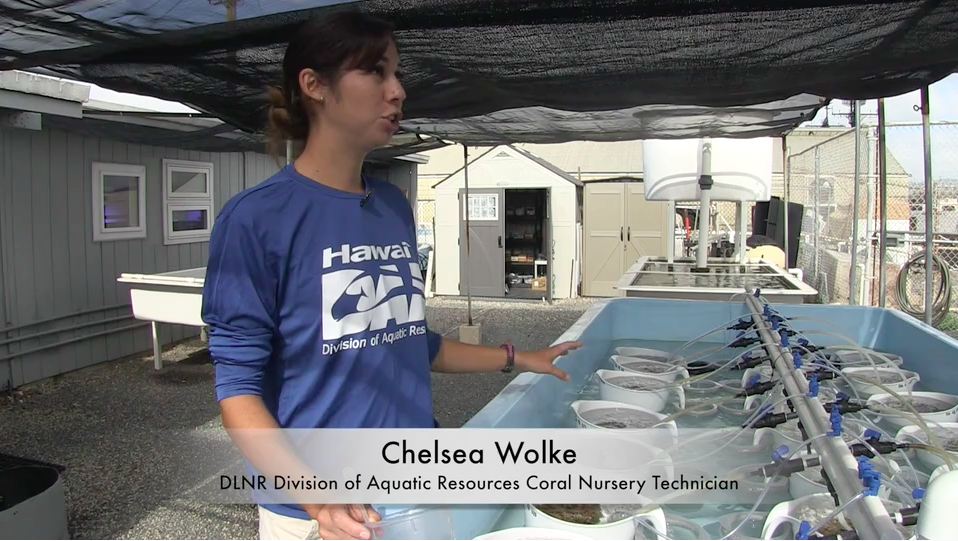02/11/16 – New State Coral Nursery Provides “Insurance” For Lost or Damaged Reefs, Large, Native Corals Being Grown Using Fast-Growth Protocol
Posted on Feb 11, 2016 in Aquatic Resources, News Releases, sliderDEPARTMENT OF LAND AND NATURAL RESOURCES
News Release
| DAVID Y. IGE GOVERNOR |
SUZANNE D. CASE
CHAIRPERSON |
For Immediate News Release February 11, 2016
(Click on image to watch video)
NEW STATE CORAL NURSERY PROVIDES “INSURANCE”
FOR LOST OR DAMAGED REEFS
Large, Native Corals Being Grown Using Fast-Growth Protocol
(HONOLULU) – In one corner of the Anuenue Fisheries Research Center on Oahu’s Sand Island, a modest collection of buildings has become home to the DLNR Division of Aquatic Resources (DAR) Coral Restoration Nursery. Part neonatal intensive care unit and part bank for Hawaii’s native corals, the new nursery aims to use professional-level coral husbandry techniques to grow small fragments of a coral colony, recombine them into large colonies, and then transplant them into the field in a fraction of the time it would take these corals to grow naturally.
DAR Coral Biologist David Gulko explains, “Most coral nurseries around the world are in situ, meaning they are in the field. These types of nurseries excel at raising naturally fast-growing species of corals, which are not components of major reefs in the Main Hawaiian Islands. At our Coral Restoration Nursery we’re focusing on ex situ or a shore-based nursery where we can grow large-size, adult colonies of coral for restoration purposes in a little more than one year.”
The Hawaii nursery primarily uses corals for transplantation from harbors as they have lower ecological value compared to corals from natural areas; may be more resilient to disturbances and environmental changes; do not impact our natural reefs, and helps with upkeep and maintenance of manmade structures.
The Coral Restoration Nursery will also provide coral colonies for multiple restoration projects under the country’s first Aquatic Mitigation Bank, which primarily focuses on near-shore coral reef resources. DLNR Chair Suzanne Case said, “The mitigation bank, is akin to companies gaining carbon credits, in that costs recouped through the selling of coral restoration credits are based on lost ecological services from incidents like boat groundings and spills into the ocean.”
“Nearly one-quarter of the coral species found in Hawaii are unique to our islands and are also among the slowest growing on the planet,” according to DAR Administrator Dr. Bruce Anderson. “This means it could take well over a decade for corals to get big enough to reproduce. The Coral Restoration Nursery is using techniques that will reduce the time it takes to grow transplantable corals to about one year. We are hopeful this will help recover reefs which have been seriously degraded by human impacts like coastal development, vessel groundings, pollution events, along with environmental factors such as climate change.”
DAR’s Fast-Growth Protocol begins with the removal of a small coral from somewhere like a harbor piling. It is then quarantined in the nursery before being fragmented into a small living pieces. Each of these genetically-identical fragments are then exposed to optimal light, water and nutrient conditions before being re-aggregated together to create at least a 40 cm colony. Prior to being transplanted back into the ocean it is put in an acclimation tank which duplicates the conditions it will experience once it’s transplanted onto the target restoration reef. Gulko concludes, “The technique makes use of non-coral reef source material (harbors, etc.), and provides protection from disease, water quality issues, aquatic invasive species, predation and competition to create re-combined coral colonies in a fraction of the time it would take to grow these corals naturally.”
# # #
Media Contact:
Dan Dennison
Hawaii Dept. of Land and Natural Resources
Senior Communications Manager
Office of the Chairperson-Communications Office
1151 Punchbowl Street, Room 131
Honolulu, HI 96813
(808) 587-0407
